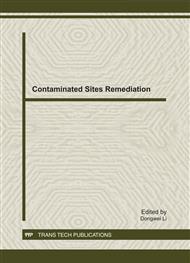p.126
p.132
p.139
p.144
p.150
p.156
p.161
p.166
p.172
Thermal Desorption of Nitrobenzene-Contaminated Soil in a Vertical Heating Oven
Abstract:
The effects of desorption temperature, air flow rate and initial soil moisture on the desorption efficiency of nitrobenzene from contaminated soil were investigated. Experiments were conducted with Yellow-brown soil contaminated by nitrobenzene in a vertical heating oven. Results showed that there was a trend that desorption efficiency of nitrobenzene increased with the increase of desorption temperature. At 250 °C, when desorption time was 30 min, desorption efficiency reached 99.8%, and the residual concentration of nitrobenzene in treated soil was only 0.3 mg/kg, which was far less than the A-level limit of Standard of Soil Quality Assessment for Exhibition Sites of China (HJ 350-2007). Besides, both too high and too low air flow rates were not in favor of nitrobenzene desorption. When the air flow rate was 2.6 m3/h, a maximal desorption efficiency reached during the early thermal desorption. In addition, initial soil moisture had a significant influence on desorption efficiency during the early thermal desorption. Nevertheless, with increasing desorption time, the effect of soil moisture diminished gradually and when desorption time reached 30 min, the effect nearly disappeared. The results obtained from this work could provide some scientific foundations for the practical soil remediation for nitrobenzene-contaminated sites by thermal desorption technology.
Info:
Periodical:
Pages:
150-155
Citation:
Online since:
December 2011
Authors:
Keywords:
Price:
Сopyright:
© 2012 Trans Tech Publications Ltd. All Rights Reserved
Share:
Citation:


